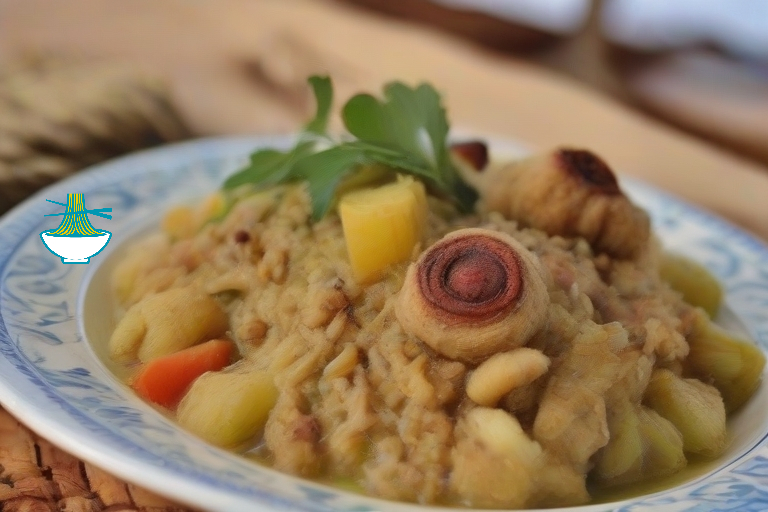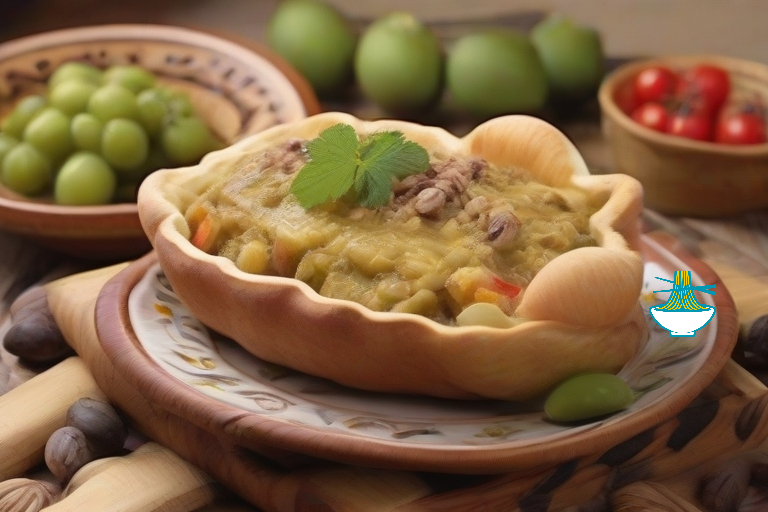Welcome to the vibrant world of Aruba cuisine, where the flavors of the Caribbean Sea meet rich cultural traditions. One dish that embodies this unique culinary heritage is "Sòpi di Piska" – Aruban Fish Soup. This beloved seafood dish highlights the island's abundant maritime resources, featuring fresh fish, aromatic spices, and local vegetables, creating a flavorful experience that tells the story of Aruba's coastal life.
As we explore the nutritional benefits of Sòpi di Piska, we discover that it is not only a treat for the taste buds but also a source of essential nutrients. Packed with omega-3 fatty acids, protein, and vitamins, this dish supports heart health, boosts the immune system, and promotes overall well-being. However, as with any seafood dish, moderation is key, especially considering the potential for mercury content in certain fish species.

Ingredients:
- 1 lb mixed fish fillets (such as grouper, snapper, or any white fish), cut into bite-sized pieces
- 1 lb shrimp, peeled and deveined
- 1/2 lb mussels, cleaned and debearded
- 1/2 lb clams, scrubbed
- 1 onion, finely chopped
- 2 tomatoes, diced
- 1 bell pepper, diced
- 2 celery stalks, chopped
- 2 carrots, peeled and sliced
- 3 cloves garlic, minced
- 1 scotch bonnet pepper, whole (optional, for heat)
- 1 cup okra, sliced (optional)
- 1 cup pumpkin, diced
- 1 plantain, sliced
- 1 cup yam or sweet potato, diced
- 1 cup coconut milk
- 1 lime, juiced
- 2 tablespoons vegetable oil
- 1 teaspoon ground cumin
- 1 teaspoon dried thyme
- Salt and pepper to taste
- Fresh cilantro or parsley for garnish
- Lime wedges for serving
- Cooked rice or bread for serving
Instructions:
- Prepare the Seafood: Rinse the fish, shrimp, mussels, and clams thoroughly. Pat them dry with paper towels.
- Sauté Aromatics: In a large pot, heat the vegetable oil over medium heat. Add the chopped onions, garlic, bell pepper, and celery. Sauté until the vegetables are softened.
- Add Tomatoes and Spices: Stir in the diced tomatoes, cumin, thyme, and a pinch of salt and pepper. Cook until the tomatoes break down and the mixture becomes fragrant.
- Incorporate Coconut Milk: Pour in the coconut milk and bring the mixture to a gentle simmer.
- Add Vegetables: Add the carrots, pumpkin, plantain, yam or sweet potato, and okra (if using). Stir well to combine.
Add Seafood: Carefully add the fish, shrimp, mussels, and clams to the pot. Allow them to cook for a few minutes until the seafood starts to turn opaque.
- Simmer: Pour in enough water to cover the ingredients, add the scotch bonnet pepper (whole), and bring the soup to a simmer. Reduce the heat to low and let it simmer for about 20-25 minutes, allowing the flavors to meld together.
- Season and Finish: Season the soup with salt and pepper to taste. Add the lime juice for a burst of citrus freshness.
- Serve: Ladle the ARUBA Sòpi di Piska into bowls, making sure to include a variety of seafood and vegetables in each serving. Garnish with fresh cilantro or parsley.
- Accompaniments: Serve the soup with lime wedges on the side and your choice of cooked rice or bread.
Enjoy your journey into the delightful flavors of ARUBA Sòpi di Piska!
Frequently Asked Questions
What is the origin of "Sòpi di Piska"?
- Sòpi di Piska is a traditional Aruban fish soup deeply rooted in the island's culture. The dish reflects Aruba’s rich maritime heritage, where fresh seafood and local vegetables are staples in everyday cooking.
Can the recipe be modified for vegetarians?
- Yes, replace the seafood with plant-based proteins like tofu or chickpeas. Use vegetable stock instead of fish stock, and enhance the flavor with seaweed or smoked paprika.
What are the best types of fish to use for this recipe?
- White, flaky fish such as grouper, snapper, or cod work best. These types of fish hold their shape well and absorb the soup’s rich flavors.
Can the recipe be prepared in advance?
- The soup base can be made ahead and refrigerated for up to two days. Add the seafood just before serving to ensure it remains tender and fresh.
How can I control the spice level in this dish?
- To adjust the heat:
- Use a smaller piece of the scotch bonnet pepper or omit it entirely.
- For a milder alternative, use red bell pepper or smoked paprika.
Are there any risks associated with eating seafood?
- Yes, potential risks include:
- Mercury Exposure: Avoid high-mercury fish like swordfish or king mackerel. Stick to low-mercury options such as snapper or grouper.
- Allergies: Individuals allergic to shellfish should avoid shrimp, mussels, and clams.
Can this dish be frozen?
- It is not recommended to freeze the dish as seafood may lose its texture upon reheating. The base can be frozen separately, and fresh seafood can be added later.
Nutritional Values
note that the actual nutritional content can vary based on factors such as specific brands, preparation methods, and ingredient sizes. The values below are general estimates:
Per 100g Serving (where applicable):
Mixed Fish Fillets:
Calories: 85
- Protein: 18g
- Fat: 1g
- Carbohydrates: 0g
benefits:
- Rich in high-quality protein.
- Good source of omega-3 fatty acids, promoting heart health.
- Provides essential vitamins and minerals, such as vitamin D and selenium.
Shrimp:
- Calories: 85
- Protein: 20g
- Fat: 1g
- Carbohydrates: 0g
benefits:
- Low in calories and rich in protein.
- Contains antioxidants like astaxanthin.
- Good source of selenium, copper, and zinc.
Mussels:
- Calories: 73
- Protein: 12g
- Fat: 2g
- Carbohydrates: 4g
benefits:
- Excellent source of lean protein.
- High in vitamin B12, essential for nerve function.
- Rich in iron and other minerals.
Clams:
- Calories: 24
- Protein: 4g
- Fat: 0g
- Carbohydrates: 2g
benefits:
- Low in calories and high in protein.
- Good source of iron, zinc, and vitamin B12.
- Contains omega-3 fatty acids.
Onion:
- Calories: 40
- Protein: 1g
- Fat: 0g
- Carbohydrates: 10g
benefits:
- Contains antioxidants with potential anti-inflammatory benefits.
- Rich in vitamins C and B, promoting immune health.
- May help regulate blood sugar levels.
Tomatoes:
- Calories: 18
- Protein: 1g
- Fat: 0g
- Carbohydrates: 4g
benefits:
- High in vitamins A and C, supporting skin health.
- Rich in lycopene, known for its antioxidant properties.
- Contains potassium for heart health.
Bell Pepper:
- Calories: 31
- Protein: 1g
- Fat: 0g
- Carbohydrates: 7g
benefits:
- Excellent source of vitamin C, supporting immune function.
- Contains antioxidants and anti-inflammatory properties.
- Good source of vitamins A and B6.
Celery:
- Calories: 16
- Protein: 0.7g
- Fat: 0.2g
- Carbohydrates: 3g
benefits:
- Low in calories and high in fiber.
- Contains antioxidants and anti-inflammatory compounds.
- May contribute to improved digestion.
Carrots:
- Calories: 41
- Protein: 0.9g
- Fat: 0.2g
- Carbohydrates: 10g
benefits:
- Rich in beta-carotene, promoting eye health.
- High in vitamins A and K.
- Contains antioxidants with potential cancer-fighting properties.
Garlic:
- Calories: 149
- Protein: 6g
- Fat: 0.5g
- Carbohydrates: 33g
benefits:
- Contains allicin with antibacterial and antiviral properties.
- May help lower cholesterol levels.
- Has anti-inflammatory and antioxidant effects.
Okra:
- Calories: 33
- Protein: 2g
- Fat: 0g
- Carbohydrates: 7g
benefits:
- High in fiber, aiding digestion.
- Contains vitamins C and K.
- Rich in antioxidants.
Pumpkin:
- Calories: 26
- Protein: 1g
- Fat: 0.1g
- Carbohydrates: 7g
benefits:
- High in fiber and low in calories.
- Rich in vitamins A and C.
- Contains potassium for heart health.
Plantain:
- Calories: 122
- Protein: 1.3g
- Fat: 0.4g
- Carbohydrates: 32g
benefits:
- Good source of complex carbohydrates.
- Contains dietary fiber and potassium.
- Provides vitamins A and C.
Yam or Sweet Potato:
- Calories: 118
- Protein: 1.6g
- Fat: 0.1g
- Carbohydrates: 28g
benefits:
- High in fiber and rich in complex carbohydrates.
- Excellent source of vitamins A and C.
- Provides potassium and manganese.
Coconut Milk (1 cup):
- Calories: 552
- Protein: 5.5g
- Fat: 57g
- Carbohydrates: 13g
benefits:
- Adds creaminess and flavor.
- Contains healthy fats, including medium-chain triglycerides.
- Provides essential minerals like manganese and copper.
Lime Juice:
- Calories: 30
- Protein: 0.6g
- Fat: 0.2g
- Carbohydrates: 10g
benefits:
- Rich in vitamin C, supporting immune function.
- Contains antioxidants.
- Adds a refreshing citrus flavor.
Vegetable Oil (2 tablespoons):
- Calories: 240
- Protein: 0g
- Fat: 28g
- Carbohydrates: 0g
benefits:
- Adds healthy fats to the dish.
- Contains vitamin E, an antioxidant.
- May have anti-inflammatory effects.
Ground Cumin (1 teaspoon):
- Calories: 8
- Protein: 0.4g
- Fat: 0.5g
- Carbohydrates: 1.4g
benefits:
- Adds a warm and earthy flavor.
- Contains antioxidants.
- May have anti-inflammatory propertie
Dried Thyme (1 teaspoon):
- Calories: 3
- Protein: 0.1g
- Fat: 0.1g
- Carbohydrates: 0.6g
benefits:
- Adds aromatic flavor.
- Contains antioxidants and anti-inflammatory compounds.
- May have antimicrobial properties.
Cilantro or Parsley:
- Calories: 23
- Protein: 2.1g
- Fat: 0.5g
- Carbohydrates: 3.7g
benefits:
- Adds freshness and flavor.
- Contains vitamins A and K.
- May have detoxifying properties.
Nutritional value per serving
- An approximate nutritional breakdown per serving (1 cup):
- Calories: 200-250 (varies based on ingredients)
- Protein: 20-25g
- Fat: 8-12g
- Carbohydrates: 10-15g
These values are approximate and may vary based on specific brands and preparation methods. Adjustments should be made based on the actual products used.


Comments